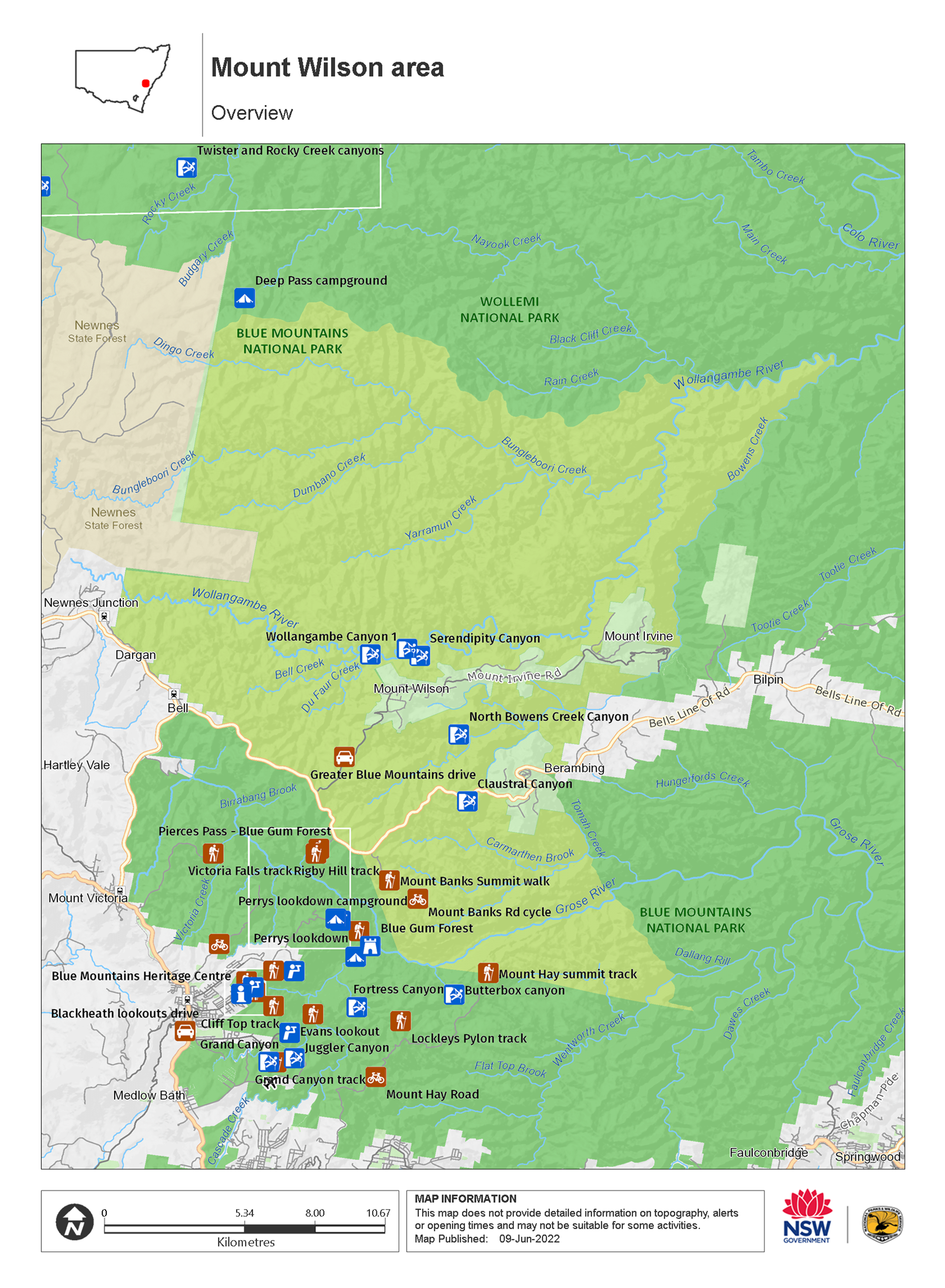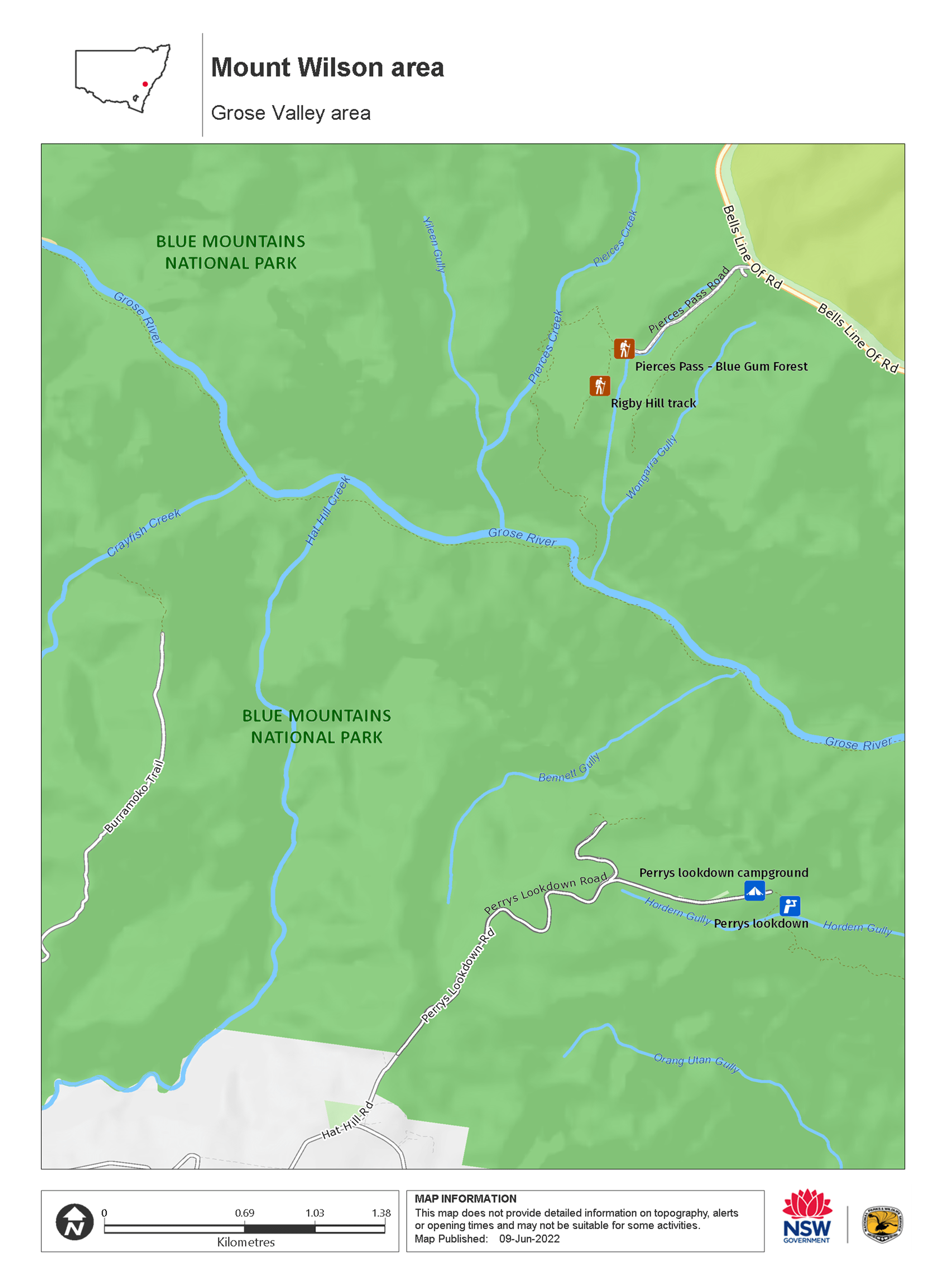Mount Wilson area
Blue Mountains National Park
Overview
Visit the natural wonders of Mount Wilson area on an exhilarating walk or mountain bike ride. Hike to Mount Banks, or explore canyons and wilderness in this remote corner of Blue Mountains National Park.
Read more about Mount Wilson area
Mount Banks picnic area is the perfect start to your Mount Wilson day trip. Breathe in the fresh air, spread out the picnic blanket and enjoy a quiet lunch surrounded by nature.
Hikers can get their heart rate up on the challenging Mount Banks Summit walk (1049m). Climb through windswept heath for staggering views across the Grose Wilderness. The fertile summit is home to tall monkey gum forest, a favourite habitat for lyrebirds, wombats and nocturnal greater gliders.
Mount Banks Road cycle route also starts from the picnic area. Ride or walk deep into the wilderness, and marvel at the 510m-high Banks Wall plunging into the Grose Valley. It’s especially beautiful in September and October, when the track is dotted with red waratahs, grevilleas and delicate native iris flowers.
Take a leisurely drive along the winding Bells Line of Road, part of the Greater Blue Mountains Drive. You don’t have to go far to find a scenic viewpoint. Stretch your legs on the short Walls lookout track, near Pierces Pass picnic area. You'll have magnificent views of Mount Banks and Mount Hay. This is also where intrepid hikers can tackle the Pierces Pass to Blue Gum Forest wilderness walk.
Why not detour to the historic village of Mount Wilson. Here, you can enjoy the short walk to Du Faurs Rocks lookout and Chinamans Hat. Explore the narrow canyons and gorges of the Wollangambe Wilderness on a tour, or stay overnight to make the most of this spectacular area.
Local alerts
For the latest updates on fires, closures and other alerts in this area, see https://www.nationalparks.nsw.gov.au/visit-a-park/parks/mount-wilson-area/local-alerts
Map

Map

Map legend

Contact
- in Blue Mountains National Park in the Sydney and surrounds region
Mount Wilson area is always open but some locations may close at times due to poor weather or fire danger.
-
-
Blue Mountains Heritage Centre and Blackheath office
02 4787 8877
Contact hours: 9am to 4pm daily. Closed Christmas Day. - 270 Govetts Leap Road, Blackheath NSW 2785
-
Email: bluemountains.heritagecentre@environment.nsw.gov.au
-
Blue Mountains Heritage Centre and Blackheath office
Visitor info
All the practical information you need to know about the Mount Wilson area.
Getting there and parking
To get to the Mount Wilson area in Blue Mountains National Park:
From Sydney:
- Take the Bells Line of Road from Richmond. Mount Banks turnoff is about 10km past Mount Tomah.
- Or, head west on the M4 and Great Western Highway towards Lithgow,
- At Mount Victoria, turn off the highway onto Darling Causeway and follow to the end. Then turn right onto Bells Line of Road.
From Lithgow:
- Follow the Great Western Highway east toward Sydney,
- At Mount Victoria, turn left onto Darling Causeway and follow to the end. Then turn right onto Bells Line of Road.
- You can also follow Chifley Road from Lithgow, which becomes Bells Line of Road.
Parking
- Serendipity Canyon See on map
Road quality
- Mixture of sealed and unsealed roads
Best times to visit
Mount Wilson area is a remote and scenic place to visit. Here are some of the highlights.
Autumn
Autumn brings crisp weather and clear blue skies perfect for cycling, trail running or walking. Well-prepared, experienced hikers can tackle the walk from Pierces Pass to Blue Gum Forest, which goes deep into the Grose Wilderness. En route to the national park, visit the nearby cool climate Blue Mountains Botanic Garden, off the Bells Line of Road at Mount Tomah.
Spring
September and October are prime time for wildflowers and bird watching. Along the tracks and trails near Mount Banks vibrant red waratahs bloom, as well as grevilleas, banksias, and grass trees. After rain, rockpools fill on the heath and bright green or orange lichens come to life. In damp, shady areas look out for blue dampiera or insect-eating sticky sundews. Rare pink flannel flowers germinate after bushfires and rain. Bring your binoculars to spot a wedge-tailed eagle, peregrine falcon, or black cockatoo riding the thermals above Grose Valley.
Summer
Escape the summer crowds and heat to enjoy remote wilderness and spectacular scenery. Du Faurs Rocks lookout and Chinamans Hat are great short walks from Mount Wilson fire station, with fantastic rock formations and wilderness views. The fine weather makes this a perfect time to enjoy a nature picnic with local produce, followed by a gentle walk. This is also the best (and safest) time of year to descend into the remote canyons on an introductory canyoning tour.
Facilities
Maps and downloads
Permitted
Walking and cycling groups in the Grose Wilderness, including around Mount Banks, are limited to 8 people.
Camp fires and solid fuel burners
In designated fireplaces only.
Prohibited
Gathering firewood
Pets
Pets and domestic animals (other than certified assistance animals) are not permitted. Find out which regional parks allow dog walking and see the pets in parks policy for more information.
Smoking
NSW national parks are no smoking areas.
Nearby towns
Blackheath (17km km)
The magnificent Govetts Leap waterfall drops a whopping 180m to the base of the cliff. The 'ozone-laden' air of the Blue Mountains was promoted as a health tonic since the early 1800s, and when you get there, you'll realise why.
Lithgow (18km km)
Hassans Walls Lookout, near Lithgow, is the highest in the Blue Mountains. Admire Mt Wilson, Mt York, Mt Tarana and Mt Blaxland as well as the pretty Hartley Valley below. To the south are the Kanimbla and Megalong valley and Mt Bindo. While there, go for a walk or ride around the lookout.
Windsor (48km km)
Explore Windsor's historic buildings, including St Matthew's Anglican Church (1817), Windsor Court House (1822), and the Macquarie Arms Hotel (1815). Bring a picnic or your boat and enjoy the beautiful riverside parks in Windsor including Howe Park and Governor Phillip Park.
Learn more
Mount Wilson area is a special place. Here are just some of the reasons why:
Plants and animals protected in this park
Animals
-

Sugar glider (Petaurus breviceps)
The sugar glider is a tree-dwelling Australian native marsupial, found in tall eucalypt forests and woodlands along eastern NSW. The nocturnal sugar glider feeds on insects and birds, and satisfies its sweet tooth with nectar and pollens.
-

Bare-nosed wombat (Vombatus ursinus)
A large, squat marsupial, the Australian bare-nosed wombat is a burrowing mammal found in coastal forests and mountain ranges across NSW and Victoria. The only other remaining species of wombat in NSW, the endangered southern hairy-nosed wombat, was considered extinct until relatively recently.
-

Yellow-tailed black cockatoo (Calyptorhynchus funereus)
The yellow-tailed black cockatoo is one of the largest species of parrot. With dusty-black plumage, they have a yellow tail and cheek patch. They’re easily spotted while bird watching, as they feed on seeds in native forests and pine plantations.
-

Superb fairy wren (Malurus cyaneus)
The striking blue and black plumage of the adult male superb fairy wren makes for colourful bird watching across south-eastern Australia. The sociable superb fairy wrens, or blue wrens, are Australian birds living in groups consisting of a dominant male, mouse-brown female ‘jenny wrens’ and several tawny-brown juveniles.
-

Superb lyrebird (Menura novaehollandiae)
With a complex mimicking call and an elaborate courtship dance to match, the superb lyrebird is one of the most spectacular Australian animals. A bird watching must-see, the superb lyrebird can be found in rainforests and wet woodlands across eastern NSW and Victoria.
-

Swamp wallaby (Wallabia bicolor)
The swamp wallaby, also known as the black wallaby or black pademelon, lives in the dense understorey of rainforests, woodlands and dry sclerophyll forest along eastern Australia. This unique Australian macropod has a dark black-grey coat with a distinctive light-coloured cheek stripe.
-

Wedge-tailed eagle (Aquila audax)
With a wingspan of up to 2.5m, the wedge-tailed eagle is Australia’s largest bird of prey. These Australian animals are found in woodlands across NSW, and have the ability to soar to heights of over 2km. If you’re bird watching, look out for the distinctive diamond-shaped tail of the eagle.
-

Eastern bentwing-bat (Miniopterus schreibersii oceanensis)
Eastern bentwing-bats congregate in caves across the east and north-west coasts of Australia, in colonies of up to 150,000. These small Australian animals weigh around 13-17g and can reach speeds of up to 50km per hour. Eastern bentwing-bats use both sight and echolocation to catch small insects mid-air.
Plants
-

Blueberry ash (Elaeocarpus reticulatus)
The blueberry ash is a rainforest shrub which produces blue olive-shaped berries and spectacular bell-shaped flowers, which often appear on the plant together. It is a tall slender shrub or small tree found in rainforest, tall eucalypt forest and coastal bushland in eastern NSW, south-east Queensland and Victoria.
-

Flannel flower (Actinotus helianthi)
The delicate flannel flower is so named because of the soft woolly feel of the plant. Growing in the NSW south coast region, extending to Narrabri in the Central West and up to south-east Queensland, its white or pink flowers bloom all year long, with an extra burst of colour in the spring.
-

Grass tree (Xanthorrea spp.)
An iconic part of the Australian landscape, the grass tree is widespread across eastern NSW. These Australian native plants have a thick fire-blackened trunk and long spiked leaves. They are found in heath and open forests across eastern NSW. The grass tree grows 1-5m in height and produces striking white-flowered spikes which grow up to 1m long.
-

Waratah (Telopea speciosissima)
The beautiful waratah is not only the NSW floral emblem, it's also one of the best-known Australian native plants. This iconic Australian bush flower can be found on sandstone ridges around Sydney, in nearby mountain ranges and on the NSW South Coast. The waratah has a vibrant crimson flowerhead, measuring up to 15cm across, and blossoms in spring.
-

Old man banksia (Banksia serrata)
Hardy Australian native plants, old man banksias can be found along the coast, and in the dry sclerophyll forests and sandstone mountain ranges of NSW. With roughened bark and gnarled limbs, they produce a distinctive cylindrical yellow-green banksia flower which blossoms from summer to early autumn.
-

Smooth-barked apple (Angophora costata)
Smooth-barked apple gums, also known as Sydney red gum or rusty gum trees, are Australian native plants found along the NSW coast, and in the Sydney basin and parts of Queensland. Growing to heights of 15-30m, the russet-coloured angophoras shed their bark in spring to reveal spectacular new salmon-coloured bark.
Environments in this area
What we're doing
Mount Wilson area has management strategies in place to protect and conserve the values of this park. View the detailed park and fire management documents. Here is just some of the work we’re doing to conserve these values:

